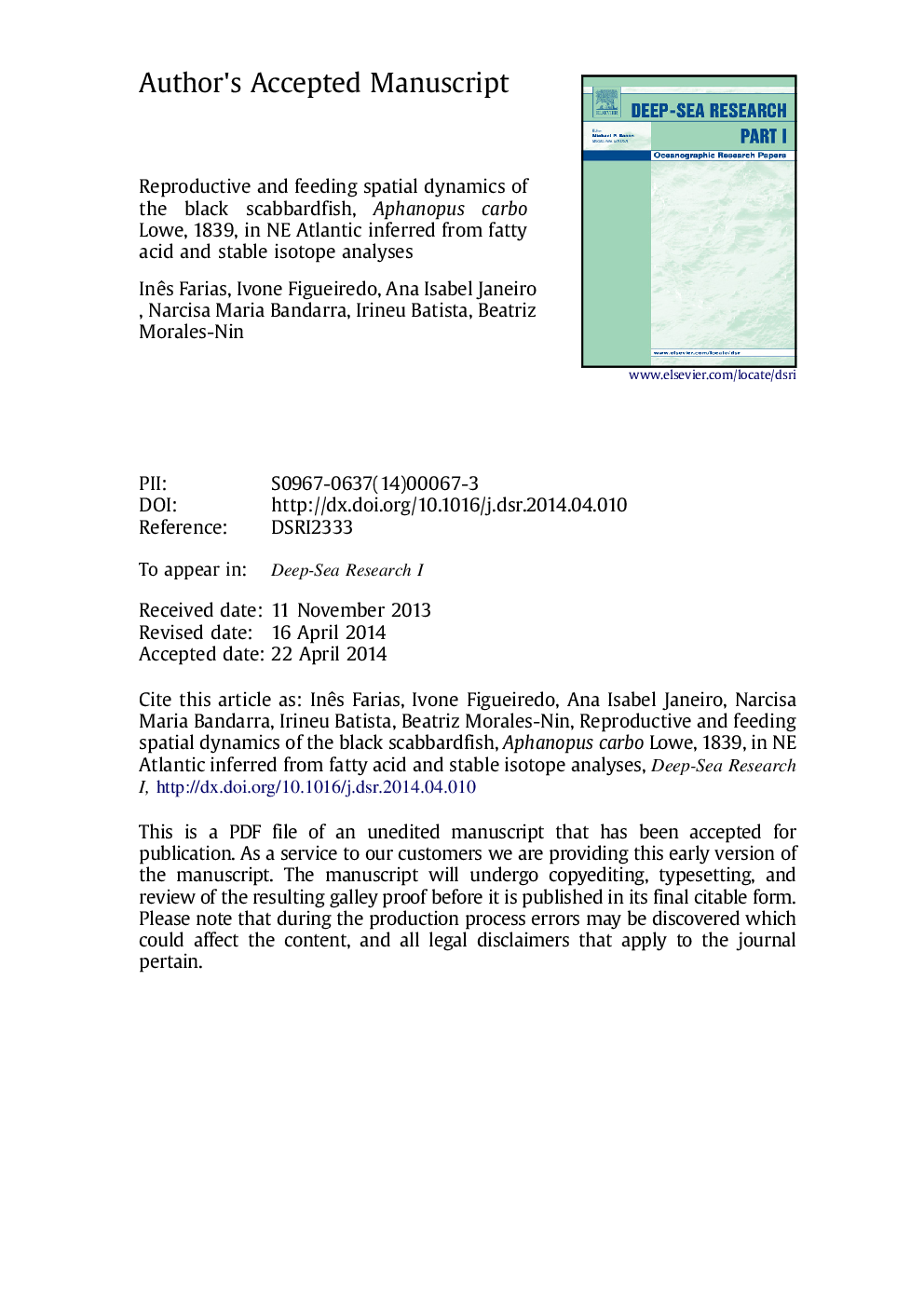| کد مقاله | کد نشریه | سال انتشار | مقاله انگلیسی | نسخه تمام متن |
|---|---|---|---|---|
| 6383685 | 1626341 | 2014 | 41 صفحه PDF | دانلود رایگان |
عنوان انگلیسی مقاله ISI
Reproductive and feeding spatial dynamics of the black scabbardfish, Aphanopus carbo Lowe, 1839, in NE Atlantic inferred from fatty acid and stable isotope analyses
دانلود مقاله + سفارش ترجمه
دانلود مقاله ISI انگلیسی
رایگان برای ایرانیان
کلمات کلیدی
موضوعات مرتبط
مهندسی و علوم پایه
علوم زمین و سیارات
زمین شناسی
پیش نمایش صفحه اول مقاله

چکیده انگلیسی
The black scabbardfish (Aphanopus carbo) is a benthopelagic species widely distributed across the NE Atlantic, where it is admitted to perform a clockwise migration throughout its life cycle stimulated by feeding and reproduction. To overcome the limitations of direct observation of this species, fatty acids profile (FA) and δ15N and δ13C stable isotopes (SI) were analyzed in the muscle tissue of the black scabbardfish and related with diet and maturity. Specimens were collected in four geographic areas in the NE Atlantic: Iceland, the west of the British Isles, mainland Portugal, and Madeira. For all areas, the FA profile was related with the different phases of the reproductive cycle and with diet, whereas the SI were related with diet, environmental characteristics, such as latitude and depth, and particulate organic matter (POM). Stomach content of black scabbardfish caught off mainland Portugal was analyzed and the most frequent prey item identified was the lophogastrid crustacean Gnathophausia zoea, followed by the cephalopod Mastigotheutis spp. and the teleost Rouleina maderensis. For specimens from Iceland and the west of the British Isles, monounsaturated fatty acids (MUFA) were the most important FA, followed by polyunsaturated (PUFA) and saturated FA (SFA), whereas for specimens from mainland Portugal and from Madeira the sequences were PUFA>MUFA>SFA and PUFA>SFA>MUFA, respectively. Immature specimens from the first three areas were found to be accumulating oleic acid which is an intermediate product of the metabolic pathway that transforms SFA to MUFA and these into PUFA. Specimens caught off Madeira were mature and showed a significant prevalence of ARA and DHA which are PUFA with an important role in reproduction. δ15N was significantly higher in the muscle of black scabbardfish from Madeira, whereas δ13C was significantly lower in specimens from Iceland. The low isotopic ratios as well as the prevalence of certain fatty acid trophic markers (FATM) connected specimens from Iceland with small prey. Results indicated that the spatial differences in physiological aspects of this species are related with diet and prey availability in Madeira, mainland Portugal, and the west of the British Isles, as well as variations in the baseline values of the primary production that are related with latitude and depth, mainly in Iceland. The allometric effect of each area׳s size ranges over δ15N supports the existence of ontogenic differences in the black scabbardfish׳s diet. This diet is typical of mobile benthopelagic predators that are opportunistic feeders.
ناشر
Database: Elsevier - ScienceDirect (ساینس دایرکت)
Journal: Deep Sea Research Part I: Oceanographic Research Papers - Volume 89, July 2014, Pages 84-93
Journal: Deep Sea Research Part I: Oceanographic Research Papers - Volume 89, July 2014, Pages 84-93
نویسندگان
Inês Farias, Ivone Figueiredo, Ana Isabel Janeiro, Narcisa Maria Bandarra, Irineu Batista, Beatriz Morales-Nin,